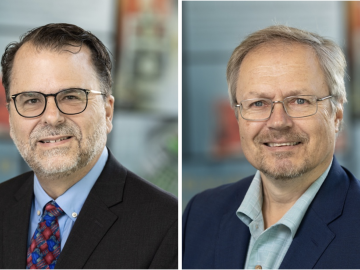
Filter News
Area of Research
- (-) Biology and Environment (178)
- (-) Clean Energy (525)
- (-) Isotopes (36)
- Advanced Manufacturing (34)
- Biological Systems (18)
- Biology and Soft Matter (5)
- Building Technologies (12)
- Chemical and Engineering Materials (4)
- Chemistry and Physics at Interfaces (11)
- Climate and Environmental Systems (14)
- Computational Biology (6)
- Computational Chemistry (5)
- Computational Engineering (5)
- Computer Science (19)
- Data (1)
- Earth Sciences (1)
- Electricity and Smart Grid (3)
- Energy Frontier Research Centers (14)
- Energy Sciences (5)
- Fossil Energy (3)
- Fuel Cycle Science and Technology (3)
- Functional Materials for Energy (16)
- Fusion and Fission (55)
- Fusion Energy (19)
- Geographic Information Science and Technology (3)
- Isotope Development and Production (3)
- Materials (433)
- Materials Characterization (2)
- Materials for Computing (36)
- Materials Synthesis from Atoms to Systems (13)
- Materials Under Extremes (12)
- Mathematics (1)
- National Security (81)
- Neutron Data Analysis and Visualization (4)
- Neutron Science (191)
- Nuclear Science and Technology (74)
- Nuclear Systems Modeling, Simulation and Validation (3)
- Nuclear Systems Technology (1)
- Quantum Condensed Matter (4)
- Quantum information Science (9)
- Reactor Technology (1)
- Renewable Energy (4)
- Sensors and Controls (5)
- Supercomputing (313)
- Transportation Systems (11)
News Type
News Topics
- 3-D Printing/Advanced Manufacturing (80)
- Advanced Reactors (6)
- Artificial Intelligence (15)
- Big Data (15)
- Bioenergy (65)
- Biology (79)
- Biomedical (26)
- Biotechnology (16)
- Buildings (38)
- Chemical Sciences (18)
- Clean Water (19)
- Climate Change (59)
- Composites (19)
- Computer Science (42)
- Coronavirus (22)
- Critical Materials (9)
- Cybersecurity (9)
- Decarbonization (47)
- Energy Storage (74)
- Environment (137)
- Exascale Computing (6)
- Fossil Energy (2)
- Frontier (5)
- Fusion (2)
- Grid (41)
- High-Performance Computing (23)
- Hydropower (9)
- Irradiation (1)
- Isotopes (26)
- Machine Learning (15)
- Materials (42)
- Materials Science (31)
- Mathematics (6)
- Mercury (10)
- Microelectronics (1)
- Microscopy (15)
- Molten Salt (1)
- Nanotechnology (11)
- National Security (8)
- Net Zero (5)
- Neutron Science (15)
- Nuclear Energy (10)
- Partnerships (12)
- Physics (2)
- Polymers (12)
- Quantum Science (2)
- Renewable Energy (2)
- Security (7)
- Simulation (18)
- Space Exploration (7)
- Statistics (1)
- Summit (13)
- Sustainable Energy (93)
- Transformational Challenge Reactor (3)
- Transportation (67)
Media Contacts

Daryl Yang is coupling his science and engineering expertise to devise new ways to measure significant changes going on in the Arctic, a region that’s warming nearly four times faster than other parts of the planet. The remote sensing technologies and modeling tools he develops and leverages for the Next-Generation Ecosystem Experiments in the Arctic project, or NGEE Arctic, help improve models of the ecosystem to better inform decision-making as the landscape changes.

Stephen Kowalski and Mikael Salonvaara received the Distinguished Service Award, which salutes members who have served the society with distinction in chapter, regional and society activities.

Three transportation researchers at the Department of Energy’s Oak Ridge National Laboratory have been elevated to senior member grade of the Institute of Electrical and Electronics Engineers, or IEEE.

Kashif Nawaz, distinguished researcher and section head for Building Technologies Research at the Department of Energy’s Oak Ridge National Laboratory, has been named a Fellow of the American Society of Mechanical Engineers, or ASME.
After retiring from Y-12, Scott Abston joined the Isotope Science and Engineering Directorate to support isotope production and work with his former manager. He now leads a team maintaining critical equipment for medical and space applications. Abston finds fulfillment in mentoring his team and is pleased with his decision to continue working.

Electric vehicles can drive longer distances if their lithium-ion batteries deliver more energy in a lighter package. A prime weight-loss candidate is the current collector, a component that often adds 10% to the weight of a battery cell without contributing energy.

The 21st Symposium on Separation Science and Technology for Energy Applications, Oct. 23-26 at the Embassy Suites by Hilton West in Knoxville, attracted 109 researchers, including some from Austria and the Czech Republic. Besides attending many technical sessions, they had the opportunity to tour the Graphite Reactor, High Flux Isotope Reactor and both supercomputers at ORNL.

It would be a challenge for any scientist to match Alexey Serov’s rate of inventions related to green hydrogen fuel. But this researcher at ORNL has 84 patents with at least 35 more under review, so his electrifying pace is unlikely to slow down any time soon.

ORNL Environmental Sciences Division Director Eric Pierce presented the division’s 2023 Distinguished Achievement Awards at the organization’s December all-hands meeting.

Researchers at ORNL became the first to 3D-print large rotating steam turbine blades for generating energy in power plants.


